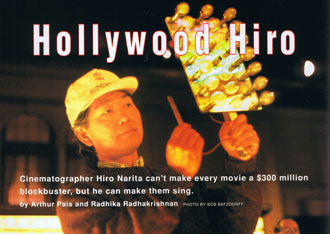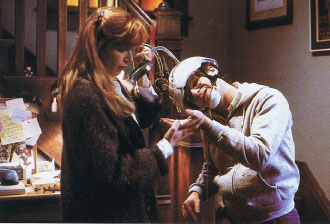|
GOLDSEA |
ASIAMS.NET |
ASIAN AMERICAN PERSONALITIES
THE 130 MOST INSPIRING ASIAN AMERICANS
OF ALL TIME
Hiro Narita
PAGE 1 OF 3
 ew in Hollywood history have demonstrated as ably as Hiro Narita the cinematographer's role in selling an audience on the drama unfolding on the screen. With a keen eye for visual logic and a loving capacity for tonal resonance, Narita has taken the DP's craft beyond camera angles and lighting to breathe life into the very texture of the filmed universe. Little wonder he was chosen for some of Hollywood's most visually challenging projects.
ew in Hollywood history have demonstrated as ably as Hiro Narita the cinematographer's role in selling an audience on the drama unfolding on the screen. With a keen eye for visual logic and a loving capacity for tonal resonance, Narita has taken the DP's craft beyond camera angles and lighting to breathe life into the very texture of the filmed universe. Little wonder he was chosen for some of Hollywood's most visually challenging projects.
The profile that follows was published in the Sep/Oct 1991 issue of Transpacific Magazine when Narita was at the height of his success as a Hollywood cinematographer on the strength of stunning footage like Honey, I Shrunk the Kids (1989), The Rocketeer (1991) and Star Trek VI: The Undiscovered Country (1991). In the 17 years since Narita has added to his stature as director of photography on diverse works like James and the Giant Peach (1996), Simon Birch (1998), Shadrach (1998), Conceiving Ada (1999), The Scorpion King (2002), Strange Culture (2007) and the upcoming Valley of the Heart's Delight (2008).
 he last ten months have been the busiest in the 25-year-career of cinematographer Hiro Narita. He shot back-to-back two big-budget movies, The Rocketeer for Walt Disney and Star Trek VI for Paramount Pictures, and worked on a documentary on celebrated sculptor Isamu Noguchi.
he last ten months have been the busiest in the 25-year-career of cinematographer Hiro Narita. He shot back-to-back two big-budget movies, The Rocketeer for Walt Disney and Star Trek VI for Paramount Pictures, and worked on a documentary on celebrated sculptor Isamu Noguchi.
Some attribute this sudden demand to the 1989 smash hit Honey, I Shrunk the Kids, which grossed $300 million in box office alone. Others see it as simply inevitable for a DP (director of photography) of Narita's creative genius and dedication. He has earned comparison with legendary James Wong Howe who shot classics like The Thin Man and Hud.
Despite the number of projects that big studios are now sending his way, Narita isn't inclined to move to Hollywood. In fact, when he and wife Barbara did move from their San Rafael home of 20 years while wrapping up photography on Star Trek VI (in which Mr Sulu, played by Transpacific columnist George Takei, is given command of his own starship), it was into a two-and-a-half-acre farm in Novato, another Bay Area town.
"I have been looking forward to moving to the new place for many reasons," Narita says. "The chicken barn will be a perfect place for my woodwork." Crafting wooden cabinets is 50-year-old Narita's other passion.
The big yard also makes the house an ideal retreat for Barbara, whose passion is gardening. The two met in the mid-1970s while she was working with the documentary division of Francis Ford Coppola's American Zoetrope Studios. She signed Narita to shoot a short film.
She gave his career a second boost later by introducing him to director/cinematographer Carroll Ballard for whom she was working as script supervisor. Narita recalls his first meetings with Ballard as purely social encounters enlivened by a shared love of carpentry.
"We talked a lot about making cabinets and such things," Narita says. Their budding friendship prompted Ballard to ask Narita to shoot Never Cry Wolf, the film that made his reputation as a top Hollywood cinematographer.
"I have always been good with my hands," Narita says.
Hiro Narita was born in Seoul, (Corea) Korea in 1941. When World War II ended his family was evacuated to picturesque Nara, Japan, where they lived for a few years before moving on to Tokyo.
Hiro's father was a doctor who hoped one day to persuade Hiro to enter the profession. Instead, the boy dreamed of becoming an artist or an architect. When Hiro was 12 his father died. His mother remarried a Japanese American. Hiro's stepfather didn't insist he pursue a medical career
In 1957, while Narita was in high school, the family moved to Hawaii. Narita struggled to adapt to the new language and to keep up with schoolwork at Oahu's Kaimuki High. Impressed by his artistic talents, his art teacher encouraged him to enter a national student competition in 1960. He did, and won a four-year scholarship to study at the school of his choice. He chose San Francisco Art Institute.
For a few days Narita considered enrolling in the fine arts department. "But something deep inside told me that I should not go into painting," he recalls, "so I chose graphic design." Majoring in graphic design and illustration, Narita twice won the award for being the outstanding design student. He earned his bachelor of fine arts degree in 1964.
A few months later he got a job with documentary filmmaker John Korty. Narita began with the expectation of of doing illustrations and related tasks. "Korty wanted someone who would design posters," Narita recalls, "but soon I was also working behind the camera."
The Vietnam War intervened. Narita was drafted and spent many months in the Pentagon's data information center making charts and graphs. The two years in the Army only sharpened his interest in films and cinematography.
"I was a movie buff from my childhood," Narita says, "and often sneaked out of home to watch films. But I didn't get to see such a variety of films as I did in the Army." Seeing masterpieces by Kurosawa, Antonioni and Bergman convinced Narita to go back into films.
"I am that type of person who is not satisfied with a single solution to a problem," he says of the intense thought that went into his career decision. He felt aspects of photography were as creative as writing or directing.
PAGE 2
Page 1 |
2 |
3
Back To Main Page
|
|
|
|


Hiro Narita was featured in Transpacific Magazine (Sep/Oct 1991) at the height of his Hollwood success.
|
|
“But something deep inside told me that I should not go into painting, so I chose graphic design.”
|

Honey, I Shrunk the Kids (1989) was Narita's first big-budget Hollywood blockbuster, grossing $300 million in its first release.
|
CONTACT US
|
ADVERTISING INFO
© 1996-2013 Asian Media Group Inc
No part of the contents of this site may be reproduced without prior written permission.
|
